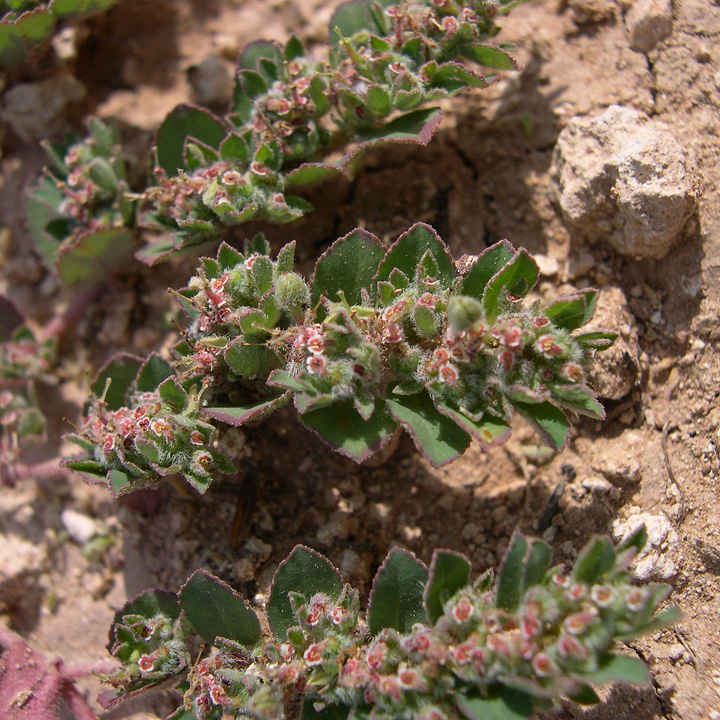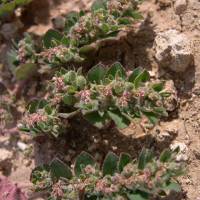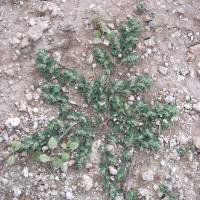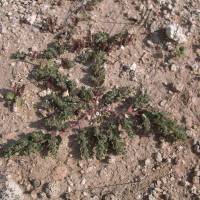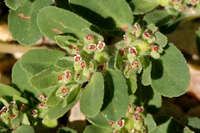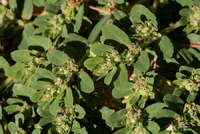Duration: Annual
Nativity: Native
Lifeform: Forb/Herb
General: Annual herb, from a slender taproot; stems usually prostrate, 5-25 cm long, sometimes with ascending tips, covered with white spreading hairs.
Leaves: Opposite along the stems, on petioles 1 mm long; blade ovate to obovate or oblong, 3-10 mm long and 2-6 mm wide, with an asymmetric base and a serrate margin, at least near the leaf tip; upper leaf surface sparsely villous to glabrate, and the lower surface usually more densely pubescent; stipules distinct or united, narrow-triangular, about 1 mm long.
Flowers: Has the highly modified flower structure characteristic of Euphorbias. Structures called cyathia appear to be individual flowers, but are composed of fused-together bracts forming a cup (involucre), with peripheral nectary glands which are often subtended by petal-like bracts called petaloid appendages. Within the cup there is a ring of inconspicuous male flowers, each reduced to a single stamen. Out of the middle protrudes a single, stalked female flower which lacks petals. In E. setiloba, the cyathia (flower structures) are clustered on dense leafy lateral branches, or sometimes solitary in the leaf axils. Involucres are cone-shaped, 1 mm high, and pubescent on the outside, with 4 red glands around the edge, which are not all the same size (unequal); each gland has a white to pink 3-lobed petaloid appendage (sometimes 1 or more of the petaloid appendages are absent, or rudamentary; occasionally all are absent); 3-9 staminate flowers.
Fruits: Capsule ovoid, 2 mm high, and hairy, the hairs concentrated on the angles; containing 3 brown, usually mottled or irregularly white-coated seeds, these 1 mm long, narrowly oblong-ovoid to ellipsoid and 3–4-angled in cross section, with a few short, irregu
Ecology: Found on rocky hillsides and washes, from 3,500-5,500 ft (1067-1676 m); flowers May-October.
Distribution: AZ east to TX, north to ND; south to c MEX.
Notes: This species belongs to the Chamaesyce subgenus of Euphorbia. Some treatments, even recent ones, continue to treat Chamaesyce as a separate genus even though molecular evidence places it within Euphorbia. Chamaesyce spp are distinct based on their leaves which are always opposite and and often have asymmetric bases; cyathia (flower structures) in leaf axils, not at branch tips, and usually with petaloid appendages; and stipules present and not gland-like. E. stictospora is a prostrate (ground-hugging) annual distinguished by its stems which have long-spreading, soft hairs; leaves and seed pods covered with appressed hairs; small leaves less than 1.5 cm long, which are serrate mostly near the tips; and cyathia (flower structures) in clusters along the central stem between leaves, with white petaloid appendages.
Ethnobotany: Unknown
Etymology: Euphorbia is named for Euphorbus, Greek physician of Juba II, King of Mauretania, while stictospora means narrow seed.
Editor: SBuckley 2010, FSCoburn 2015, AHazelton 2017
A chiefly sw. sp. with virtually entire styles, and with mottled, punctate-pitted seeds depressed-punctate at base and sharply acute at the tip, barely encroaches into our range in w. Io.
Gleason, Henry A. & Cronquist, Arthur J. 1991. Manual of vascular plants of northeastern United States and adjacent Canada. lxxv + 910 pp.
©The New York Botanical Garden. All rights reserved. Used by permission.
Plant: Prostrate annual forb branching from central point; herbage pubescent, with milky sap
Leaves: leaves opposite, inequilateral at base, margins irregularly serrate on upper half
Flowers: flowers monoecious borne in cyathia; petaloid appendages white (minute); ovary and capsule more heavily pubescent on base than anywhere else, ~1.5 mm long; seeds punctately pitted and mottled.


